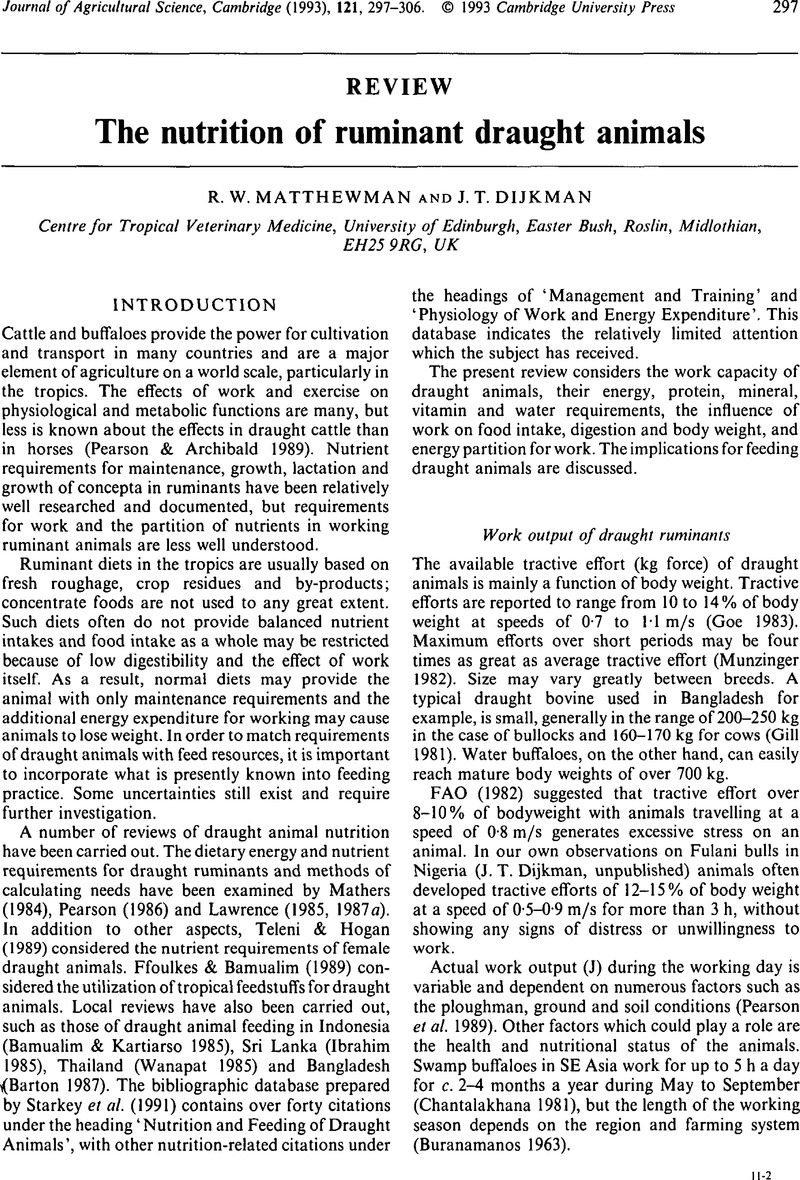Crossref Citations
This article has been cited by the following publications. This list is generated based on data provided by Crossref.
Pearson, R. Anne
and
Dijkman, Jeroen T.
1994.
Nutritional implications of work in draught animals.
Proceedings of the Nutrition Society,
Vol. 53,
Issue. 1,
p.
169.
Pérez, R.
Valenzuela, S.
Merino, V.
Cabezas, I.
García, M.
Bou, R.
and
Ortiz, P.
1996.
Energetic requirements and physiological adaptation of draught horses to ploughing work.
Animal Science,
Vol. 63,
Issue. 2,
p.
343.
Fall, A.
Pearson, R. A.
Lawrence, P. R.
and
Fernández-Rivera, S.
1997.
Nutrition of draught oxen in semi-arid west Africa. 2. Effect of work on intake, apparent digestibility and rate of passage of food through the gastro-intestinal tract in draught oxen given crop residues.
Animal Science,
Vol. 64,
Issue. 2,
p.
217.
Bennison, J. J.
Clemence, R. G.
Archibald, R. F.
Hendy, C. R. C.
and
Dempfle, L.
1998.
The effects of work and two planes of nutrition on trypanotolerant draught cattle infected with Trypanosoma congolense.
Animal Science,
Vol. 66,
Issue. 3,
p.
595.
Smil, Vaclav
1999.
Crop Residues: Agriculture's Largest Harvest.
BioScience,
Vol. 49,
Issue. 4,
p.
299.
Chawatama, S
Ndlovu, L.R
Richardson, F.D
Mhlanga, F
and
Dzama, K
2003.
A simulation model of draught animal power in smallholder farming systems. Part II: Model evaluation and application.
Agricultural Systems,
Vol. 76,
Issue. 2,
p.
441.
Chawatama, S.
Ndlovu, L.R.
Richardson, F.D.
Mhlanga, F.
and
Dzama, K.
2003.
A simulation model of draught animal power in smallholder farming systems. Part I: Context and structural overview.
Agricultural Systems,
Vol. 76,
Issue. 2,
p.
415.
Maurya, Vijai P.
Sejian, Veerasamy
Kumar, Kamal
Singh, Gyanendra
and
Naqvi, S. M. K.
2012.
Environmental Stress and Amelioration in Livestock Production.
p.
75.
Katole, Shrikant
Das, A.
Agarwal, N.
Prakash, B.
Saha, S.K.
Saini, M.
and
Sharma, A.K.
2014.
Influence of work on nutrient utilisation in semicaptive Asian elephants (Elephas maximus).
Journal of Applied Animal Research,
Vol. 42,
Issue. 4,
p.
380.
Mota-Rojas, Daniel
Braghieri, Ada
Álvarez-Macías, Adolfo
Serrapica, Francesco
Ramírez-Bribiesca, Efrén
Cruz-Monterrosa, Rosy
Masucci, Felicia
Mora-Medina, Patricia
and
Napolitano, Fabio
2021.
The Use of Draught Animals in Rural Labour.
Animals,
Vol. 11,
Issue. 9,
p.
2683.



